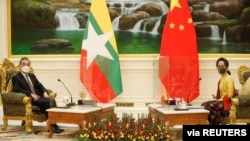Chinese Foreign Minister Wang Yi helped cinch Beijing’s hold on Myanmar with a visit last week that saw the two countries agree to push ahead with a major transportation project and lock in a five-year trade and economic pact, analysts say.
Wang also sought to remind Myanmar of China’s steadfast support ahead of a new U.S. administration expected to pay more attention to a region the two superpowers are vying to influence, they add.
The January 11-12 trip made Wang the first senior foreign delegate to visit Myanmar since a November election that returned the National League for Democracy and the country’s de facto leader, Aung San Suu Kyi, to power for a second term. It also followed Chinese President Xi Jinping’s high-profile visit a year ago, when he signed 33 bilateral deals.
Wang left Myanmar with a more modest-sounding eight, but they may, on the whole, carry more weight, said Yun Sun, China program director at the Stimson Center, a Washington think tank.
While Xi’s deals laid the groundwork for closer ties with Myanmar, “it was really Wang Yi’s job to transpire them into reality,” she said.
Back on track
Yun said the minister’s visit may well have been the most substantive by a Chinese official in a decade. Key among the new deals is a feasibility study for the second half of a planned rail line bisecting Myanmar from its border with China in the east to its Bay of Bengal coast in the west.
The line is part of the China-Myanmar Economic Corridor, an offshoot of China’s Belt and Road Initiative and its bid for a second route to the Indian Ocean to bypass the Malacca Strait, a potential chokepoint for its oil and gas imports. A deep-water port on the coast is in the works and parallel oil and gas pipelines run the route already.
Work on the corridor has been slowed by Myanmar’s fears of drowning in debt to China to pay for its share of the mega-projects, and concerns over Beijing’s sway in the country run deep.
Yun said China’s feasibility study for the first half of the rail line drew yet more blowback from locals in its path, making a deal to move ahead with the second half no mean feat.
“In terms of the political sensitivity associated with this and for all the political problems that we have witnessed about this, I think the fact that China is able to push this forward means that China is making significant progress on the ground,” she said.
A Five-Year Plan for Economic and Trade Cooperation that Wang left Myanmar with also signaled a new level of trust that relations would stay strong, Yun added.
“For China and Myanmar to already have this blueprint at the beginning of the [NLD’s] second term, I think that shows not only Myanmar is dependent on China, it also shows that China has specific strategic plans regarding the country,” she said.
A friend in need
By sending Wang to Myanmar only a year after Xi’s visit, China also wants to remind the country of its all-weather friendship when the pandemic and politics in the U.S. may leave it feeling ignored by the West, said Hervé Lemahieu, Myanmar analyst for Australia’s Lowy Institute.
“They certainly wanted to reinforce this image of being the external power with the greatest support for Myanmar,” he said.
“It’s to say basically it’s business as usual, everything’s on track despite a very turbulent pandemic year,” and that “you can expect more diplomatic protection,” he added.
China is widely seen as using its deep pockets and permanent U.N. Security Council seat to shield Myanmar from fallout over its dismal human rights record, including what the U.N. itself has called the ethnic cleansing of the country’s Rohingya minority.
Lemahieu said China has had relatively little competition for influence over Southeast Asia from the U.S. in recent years but may be expecting that to change under U.S. President Joe Biden’s administration.
“That was another thing: Let’s get in as the first foreign minister after the Myanmar elections and make sure that we’re still on good grounds just in case the Biden administration is going to push hard on Southeast Asia in the next coming months. So I think that’s the other reasoning behind Wang Yi’s trip, not only to Myanmar but to the rest of Southeast Asia,” he said.
Wang’s visit to Myanmar was the first stop on a swing through the region that also took in Brunei, Indonesia and the Philippines.
China “wants to make sure [of] its relations with the regional countries and confirm the policies of the regional countries before the new U.S. government is formed,” agreed Khin Khin Kyaw Khee, China analyst at the Institute for Strategy and Policy, a Myanmar think tank.
“They want to take the advantage by talking to these countries … before the [new] US government is formed and U.S. foreign policy toward this region is … settled,” she said.
“Damage control”
At the same time, the tour was “damage control” for a Beijing hoping to override claims by its critics, which it denies, that China inadvertently let the coronavirus pandemic sweep the globe by initially smothering local reports of the first outbreak in Wuhan, said Lemahieu.
To that end Wang announced that China would be donating 300,000 doses of its leading COVID-19 vaccine CoronaVac to Myanmar, which is struggling to secure shots for its 54 million people.
Three of Wang’s stops — Indonesia, Myanmar and the Philippines — are straining under the highest COVID-19 caseloads in the region.
In Myanmar and beyond, China is also aiming to “repackage” its Belt and Road projects, not as the debt traps some host countries fear them to be, but the spark that will reignite national economies brought down by the pandemic, Lemahieu added.
He said China wants to convince them that “it’s not just the source of the virus but it’s the source of the solution ultimately.”




